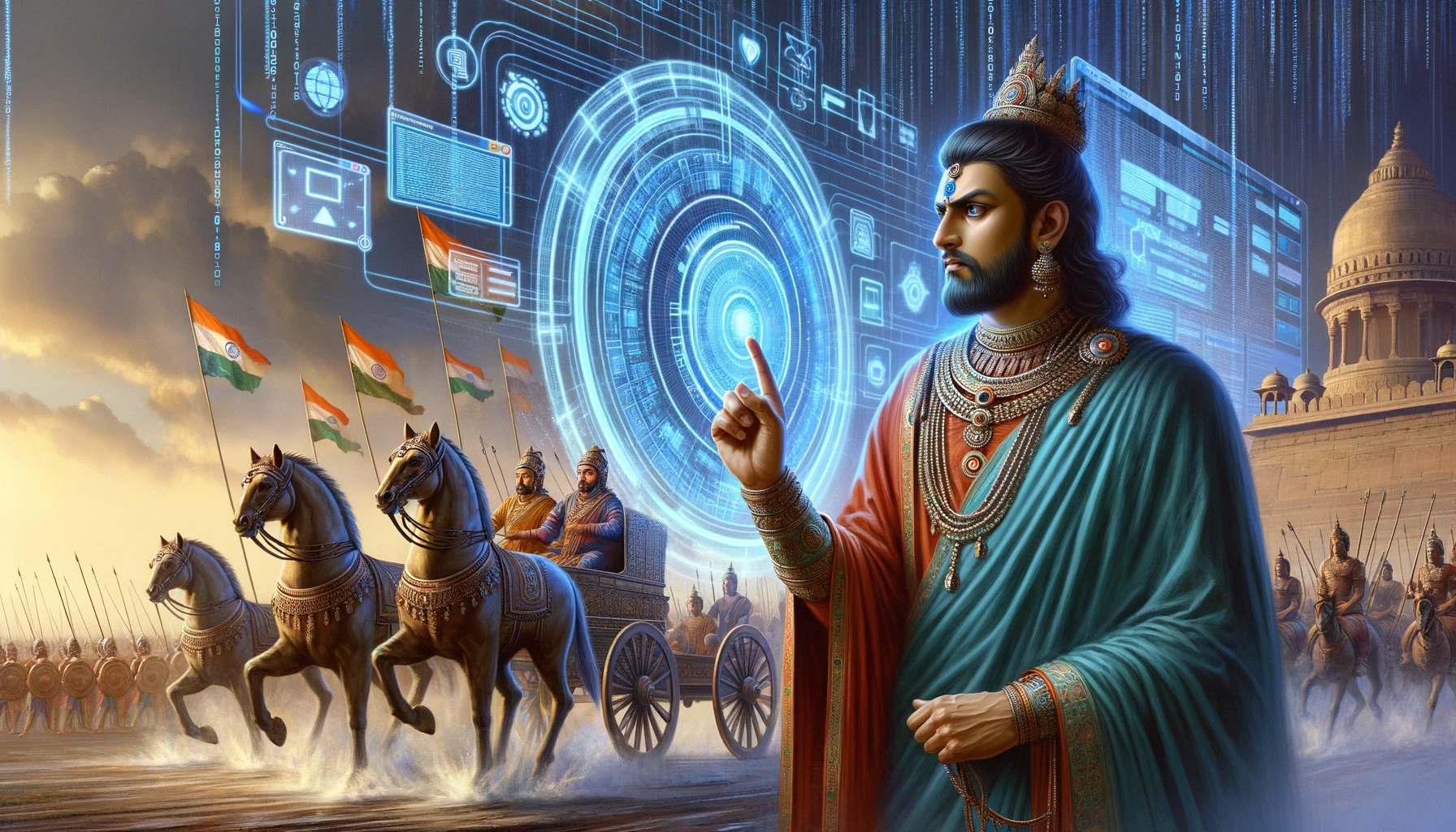The Timeless Struggle with Upgrades: From Chariots to Software
 Arpit Dwivedi
Arpit Dwivedi
In the grand tapestry of human history, innovation stands out as one of our most defining traits. From the rudimentary wheel to the sophisticated algorithms that drive our digital world, we've relentlessly pursued advancement. Yet, with every step forward, there's a familiar dance of enthusiasm met with apprehension. Imagine Emperor Ashoka, a formidable ruler whose empire spanned vast stretches of ancient India. Upon the introduction of a new 'wheel' for his chariots, he found himself in a predicament, not unlike our modern-day tech woes. This tale, humorous in its anachronism, sheds light on a universal truth: the challenges of upgrades, be it a chariot's wheel or a software patch, are as old as innovation itself.
Historical Context
The Mauryan Empire, one of ancient India's most illustrious dynasties, spanned from the Himalayas in the north to the Deccan plateau in the south. Emperor Ashoka, a central figure in this empire, is renowned not just for his vast conquests, but also for his transformative journey from a fierce warrior to a benevolent ruler, promoting peace and Buddhism.
Chariots, during this era, were symbols of power and technological ingenuity. These fast-moving vehicles, often decorated with ornate designs, were a testament to the period's technological prowess. They held significance both in ceremonial processions and as formidable tools in warfare, playing an integral role in the empire's expansion and cultural narrative.
However, as with any technological marvel, even these ancient machines had their challenges. While our anecdote about Ashoka's struggles with an "innovative wheel" is a fictional tale crafted for analogy, it underscores a universal truth. The introduction of any new technology or upgrade, be it in ancient times or the modern era, comes with its set of promises and pitfalls. And as our story suggests, navigating these challenges is a timeless endeavor, experienced by rulers and commoners alike.
The Universal Challenge of Upgrades
Throughout history, the allure of improvement and progress has driven civilizations to the pinnacle of their eras. Whether it was the construction of the grand pyramids, the invention of the printing press, or the dawn of the digital age, every epoch has had its hallmark innovations. Yet, accompanying these advancements is a shadow of challenges – the unforeseen consequences and learning curves of new technologies.
Consider the monumental architectural structures of ancient times. While they stood as testaments to human capability, the novel techniques employed often posed significant challenges, from logistical nightmares to structural failures. Similarly, the introduction of the printing press, though revolutionizing information dissemination, brought forth debates on authenticity, copyright, and the spread of misinformation.
In the context of Emperor Ashoka's fictional encounter with the new 'wheel,' this tale mirrors the dilemmas faced by many throughout history. A novel invention, though promising efficiency and superiority, can also present unexpected challenges. The wheel, while enhancing the chariot's speed and agility, introduced complexities in maneuverability, much like a software update today might bring new features at the cost of user familiarity and comfort.
The essence of this narrative is clear: with progress comes the necessity to adapt, learn, and sometimes, face unforeseen challenges. While the specifics of these challenges have evolved, the underlying theme remains consistent across ages.
Modern-Day Parallels
Software Updates and Tech Evolution:
Much like the ancient chariot upgrades, today's technological landscape is riddled with constant software updates and hardware evolutions.
Every update, though promising improved performance, often demands users to relearn and adapt, sometimes leading to initial resistance.
The Smartphone Revolution:
Remember the shift from button phones to touchscreens? The initial challenges of touch sensitivity, accidental dials, and mastering the virtual keyboard echo the struggles of our fictional Emperor Ashoka.
Over time, however, these became second nature, highlighting our capacity to adapt and evolve with technology.
The Digital Learning Curve:
Modern tools and platforms, from graphic design software to complex coding environments, come with steep learning curves.
The initial phases can be daunting, filled with errors and setbacks, but persistence often leads to mastery, just as Ashoka would have eventually mastered the new chariot wheel.
User Experience (UX) and Design:
As technology progresses, the emphasis on intuitive design and user experience has never been more crucial.
Designers and developers aim to create interfaces and functionalities that are both innovative and user-friendly, bridging the gap between advancement and usability.
By drawing parallels between ancient challenges and modern tech scenarios, it becomes evident that the journey of progress, with its highs and lows, is a timeless narrative.
The 'Undo' Dilemma
The Universal Need for a Safety Net:
From Emperor Ashoka's wish to undo the chariot mishap to our frantic searches for the 'Ctrl + Z' function after an unintended action on our computers, the yearning for an "undo" option is deeply ingrained.
It signifies our desire for control in a rapidly changing environment and the comfort of knowing we have a fallback.
Historical 'Undo' Moments:
Think of ancient architects who, upon finding structural flaws in their designs, wished for a way to revert to a previous blueprint.
Or early scientists and alchemists who, after an unsuccessful experiment, yearned to go back to the drawing board with the knowledge of their mistakes.
Modern Digital Solutions:
Today's software tools often come equipped with extensive 'undo' and 'history' features, allowing users to trace back several steps.
These functions provide a safety net, ensuring that mistakes, rather than being catastrophic, become part of the learning process.
The Psychological Comfort:
Beyond the practical application, the ability to 'undo' offers psychological comfort. It alleviates the fear of commitment to a particular action and fosters an environment of exploration and creativity.
In a world where perfection is often sought, the 'undo' feature reminds us that it's okay to make mistakes, as long as we learn and grow from them.
In essence, the 'undo' function, whether in the context of an ancient chariot or modern software, represents our innate desire for second chances and the opportunity to refine our actions.
Embracing Change While Yearning for Familiarity
The Human Resistance to Change:
At our core, humans are creatures of habit. We find comfort in the known, the familiar routines, and the tried-and-tested methods.
This is evident in our initial reluctance to adopt new technologies or methodologies, even if they promise better efficiency or results.
Historical Instances of Reluctance:
The skepticism around the first trains, was seen as monstrous machines that could never replace horse-drawn carriages.
The reluctance to adopt the metric system in certain countries, despite its global prevalence and clear advantages.
The Push-Pull of Progress:
On one hand, we're drawn to the new, the shiny, the innovative. The promise of a better future, more convenience, and improved lifestyles.
On the other hand, there's a pull towards the past, a nostalgia for simpler times, and a desire to stick to what we know.
Finding the Balance:
The key lies in acknowledging our resistance, understanding its roots, and then making informed decisions.
By merging the best of the old with the potential of the new, we can navigate change in a balanced manner, ensuring we move forward without losing touch with our roots.
To conclude this section, while the tools, technologies, and scenarios change, our intrinsic reactions to change remain remarkably consistent. By recognizing this pattern, we can approach new challenges with a blend of enthusiasm and caution, ensuring that we harness the benefits of progress while staying grounded.
Conclusion: The Timeless Dance of Progress and Adaptation
The Ever-Present Cycle:
History, in its vast expanse, showcases a repeating pattern: innovation emerges, initial resistance is faced, gradual adaptation occurs, and eventually, the new becomes the norm.
Whether it's Emperor Ashoka's fictional tale of adapting to a new chariot wheel or our contemporary challenges with the latest software updates, this cycle remains constant.
Embracing the Journey:
Instead of dreading the inevitable changes that progress brings, we can choose to embrace them as part of our collective journey.
Every hiccup, setback, or challenge faced during these transitions adds to our reservoir of experiences, enriching our personal and communal narratives.
A Call to Reflection:
As we stand at the cusp of numerous technological breakthroughs, it's worth pausing and reflecting on our past. The tales of adaptation, the struggles with newness, and the eventual mastery provide valuable insights.
By understanding our historical dance with progress, we can approach future innovations with a balanced perspective, ensuring we reap the benefits while staying true to our essence.
In the grand tapestry of human evolution, the threads of innovation and adaptation are intricately woven together. While the tools and contexts change, our core journey remains the same, reminding us of the timeless nature of our shared experiences.
Subscribe to my newsletter
Read articles from Arpit Dwivedi directly inside your inbox. Subscribe to the newsletter, and don't miss out.
Written by

Arpit Dwivedi
Arpit Dwivedi
Crafting code with a finesse that bridges the digital divide! As a Full Stack Developer, I’ve conjured innovations at industry front-runners like Infosys and Kline & Company. With a suite boasting C#, ASP.NET CORE, Angular, and the complex dance of microservices, I’m not just programming – I’m telling stories. Beyond raw code, I'm a tech translator, dishing out insights as an avid writer, leading the charge in the open-source world, and floating on the Azure cloud. From corporates to intense tech programs, my journey’s been anything but ordinary. Curiosity? It's not just a sidekick; it's my co-pilot. Eagerly scanning the horizon for the next tech marvel. 🚀